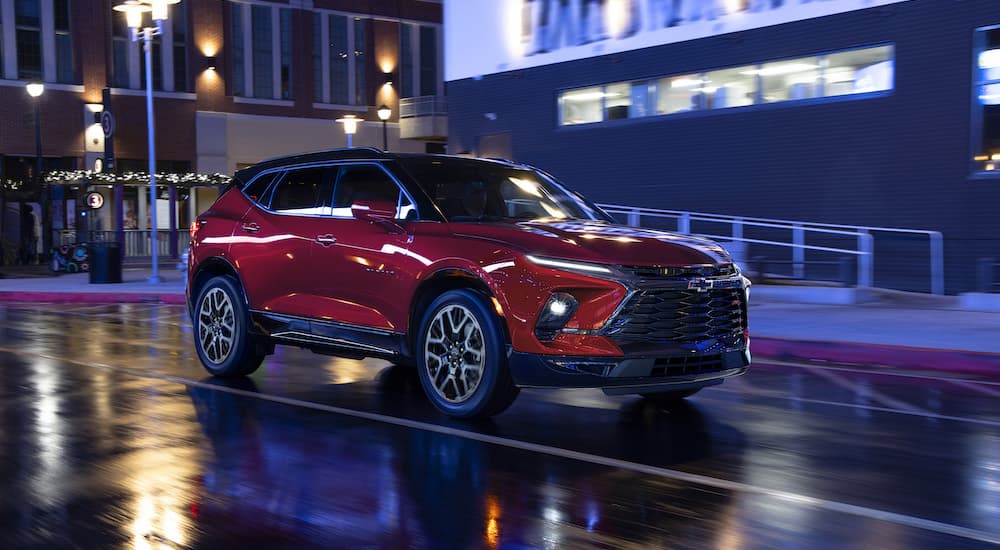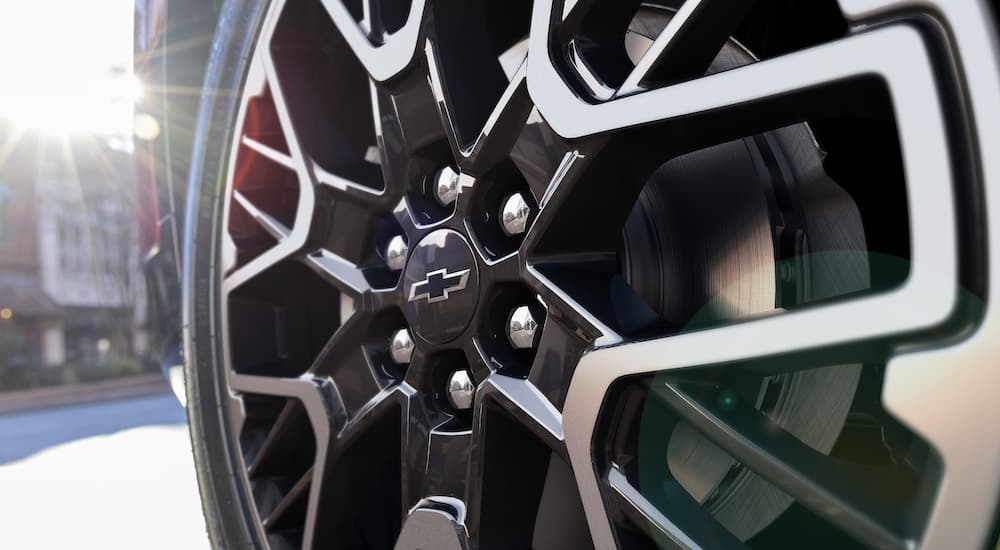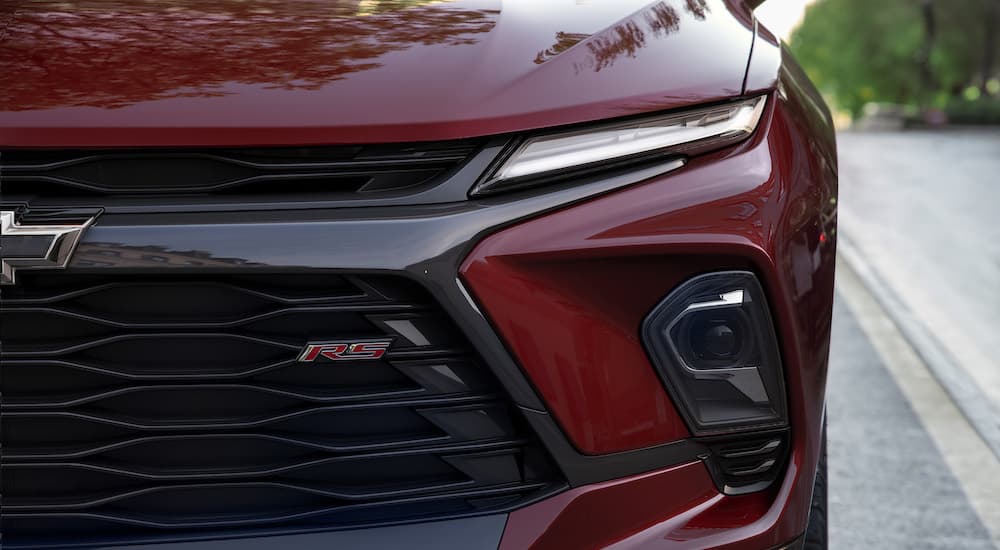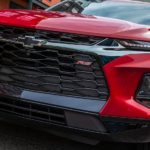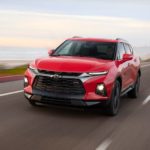The 2023 Chevy Blazer is getting a well-deserved refresh for the upcoming model year as the midsize crossover continues to draw considerable interest from consumers. As a quick peek into the Chevy archives proves, the brand has always done a great job of tweaking the Blazer to cater to changing consumer demands. This is true from the first Blazer introduced in the late the ’60s––which almost single-handedly introduced the public to the SUV concept––all the way up to the most recent 2023 model, which once again sets the standard within the category.
A look into the history of the Blazer provides an interesting perspective on how Chevy has continually reengineered the popular SUV to fit the needs of the modern driver, morphing from off-road beast to minivan replacement and finally the spritely crossover we know today, with a few fun diversions––camper, convertible, and street racer––thrown in along the way. With a new electric model on the horizon for 2024, that commitment to reinvention shows no signs of slowing down, but for now, let’s focus on how Chevy has worked tirelessly to keep the Blazer fresh throughout the years and take a look at some of the high-tech upgrades and reimagined styling coming to the SUV for 2023.
Blazing A New Path
The Blazer has long been a jewel in the Chevy lineup’s crown and is particularly notable for its ability to keep up with the times and adapt to changing consumer tastes. The Blazer, along with other genre-defying models like the Ford Bronco and Jeep Wagoneer, basically invented the sport utility vehicle segment back in the late ’60s, wedding a full-size truck frame to a spacious cabin that could fit five passengers or more. Reactions were swift and enthusiastic, with this new breed of SUVs quickly gaining market share by catering to drivers who were looking for the utility of a truck without all the inherent sacrifices in comfort and passenger seating.
Chevy’s first entry into the category, the K5 Blazer, was more versatile still, featuring a removable fiberglass top that brought the “wind in your hair” excitement of the convertible experience to the nascent SUV class. Debuting as a four-wheel drive vehicle and playing up the SUV’s “go anywhere” ethos, this early generation of Blazers were aimed squarely at off-road adventurers and had the power and hardware to back it up; including heavy-duty shocks and springs, an auxiliary battery, and two different V8 options to choose from.
The second-generation K5 Blazer would see a few modifications, including the discontinuation of the fully-removable hardtop. Instead, Chevy replaced it with a roof that could be removed over the second row and trunk, which paved the way for the introduction of the limited-run Chevy K5 Blazer Chalet. The unique model basically amounts to a factory-installed camper, replacing two-thirds of the Blazer’s seating and storage space with a camper that included a propane stove, refrigerator, and fold-out bunks.
Drivers still unsure about the off-road credentials of the K5 Blazer got more than a little encouragement in the mid-’80s when the U.S. military tapped Chevy to produce a military-grade version of the popular SUV. The M1009 CUCV might not have the same ring as “Blazer,” but with an upgraded suspension, rifle rack, and front brush guard, there was no doubting the model’s battlefield bona fides.
The Modern Blazer Emerges
The ’80s also brought the first major schism in the Blazer lineup with the introduction of a smaller option. While the O.G. Blazer had proved itself as a capable, versatile workhorse over the decades, changing tastes and rising fuel costs necessitated a new strategy on Chevy’s part. Enter the S-10 Blazer, nicknamed the “baby Blazer” for its smaller footprint and powertrain. The model proved popular with an entirely new class of drivers. In many ways, the S-10 can be seen as the forerunner of today’s 2023 Blazer: a smaller, more fuel-efficient alternative to the truck-like SUV that came before it. With a standard 2.0-liter, four-cylinder engine, the S-10 was almost a different vehicle, though an optional 2.8-liter V6 with 110 horsepower was also offered. By the time the first-generation S-10 Blazer wrapped up its run in 1994, that would be bumped up to a 165-horsepower V6.
Meanwhile, the third-generation K5 Blazer continued to deliver the power that had made the SUV so popular to begin with. With the S-10 drawing away drivers looking for a more flexible, fuel-efficient ride, the K5 was free to give into its truckier instincts, nixing the convertible roof, upping the towing capacity to 7,000 pounds, and introducing a massive 6.5-liter turbocharged diesel V8 option. Both the K5 and S-10 proved popular enough with their respective market segments that it was time for a rebranding, and it was the smaller S-10 that kept the Blazer badge while the K5 quietly transformed into a new model called the Tahoe in 1995.
With the K5 gone, it was up to the SUV-formerly-known-as-the-S-10 to split the difference. For the ’95 model year, Chevy simplified things by dubbing this new model simply the Blazer and beefed it up a bit while also making some subtle styling changes to fit a more contemporary aesthetic. These changes proved popular with both former K5 and S-10 drivers, and the Blazer quickly made in-roads with the soccer parent set thanks to its ample storage and passenger space, ride height, and overall fusion of comfort and convenience. The new Blazer also carried over the four-door configuration of the S-10, making it a popular choice for families not interested in dealing with the hassle of folding front seats to reach the second row.
The Blazer would continue to find its footing over the next few years, steadily ramping back on power in favor of comfort and amenities and essentially providing the blueprint for what would eventually come to be known as a crossover––minus the unibody design. Starting off with a 4.3-liter engine with 200 horsepower in the first generation (1996-2002), the Blazer would actually lose 10 horsepower in its second generation (2002-2005). But that’s not to say all its mud-slinging days were behind it by any means. Recognizing that the public still had a healthy appetite for a Blazer that knew how to get a little dirty, Chevy introduced a Blazer ZR2 package in 1996 featuring Bilstein shocks, skid plates, an improved rear axle, upgraded wheels, and a 3-inch lift. The Blazer Xtreme was another limited-run performance model from this generation of Blazers, kitted out with a sports suspension, body kit, and lowered ride height.
Chevy introduced an upscale trim for the Blazer in 1999 dubbed the TrailBlazer, which saw a number of luxurious upgrades, including a Bose stereo, OnStar, heated seats, and a power sunroof. The TrailBlazer would prove so popular among consumers as a Blazer trim that it was eventually spun off into its own unibody SUV in 2002. The Blazer itself would be phased out in 2005 as consumers shied away from gas-guzzling SUVs, and it would take almost 15 years for Chevy to revive the popular model.
The Present Day
That brings us into the present day, or at least 2019, when the Blazer burst back onto the scene in yet another form. Having experimented with the size and capability of the Blazer during its initial run, it’s little surprise that Chevy chose to revive the model in the era of the crossover SUV. The Blazer was primed for a unibody makeover and now slots in nicely between the compact Equinox and three-row Traverse in the brand’s crossover lineup. For 2023 the Blazer is available in four trim levels: 2LT, 3LT, RS, and Premier. All-wheel drive is available on all four trims, but the RS comes with a more advanced twin-clutch AWD system. There are also two engine options to choose from: a base 2.0-liter, 228-horsepower turbo-four and a 3.6-liter V6 with 308 horsepower that comes standard on the RS and is an optional upgrade for the 3LT and Premier.
Built on the same unibody platform as the GMC Acadia, this next-generation Blazer is nothing if not eye-catching. Designers turned to the Chevy Camaro for design inspiration, and the results speak for themselves. The new 2023 Blazer is loaded with sleek, sculpted lines, featuring an imposing grille and some styling cues––a high beltline, wide stance, interior control panel––that look like they were lifted directly from Chevy’s iconic muscle car. The headlights, daytime running lights, and taillights also got a refresh for 2023, and Chevy has expanded wheel options to include new 18″, 20″, and 21″ choices.
A slate of new color schemes rounds out the styling changes, with striking new options like Sterling Gray, Copper Bronze Metallic, and Radiant Red Metallic. Drivers opting for the Blazer’s RS trim will also have the option to upgrade to a new Nightshift Blue interior, further expanding the SUV’s customization potential. While we have yet to see any photos of the new interior color option, we’re intrigued by Chevy’s willingness to try something a little more adventurous than the typical “throw in a bunch of leather and red accents” approach.”
These aesthetic improvements are a nice touch, but it’s the interior tech upgrades that really define the 2023 Blazer. All 2023 Blazers now come standard with a 10-inch touchscreen infotainment system. While this might not seem like a drastic upgrade from the prior 8-inch option, it’s amazing how much difference those two inches can make when it comes to easily––and safely––navigating the screen while the vehicle is in operation. Chevy has also expanded wireless charging to every trim level and made adaptive cruise control an option for the 2LT and 3LT models. Other interior features for the 2023 Blazer include a 120-volt outlet, Wi-Fi hotspot, and eight-speaker Bose stereo system.
Into the Future
With a new electric Blazer EV in the works, Chevy isn’t letting up with the type of innovation that’s served the Blazer for well over the last 50 years. The popular SUV has long been a driver favorite thanks to its seamless fusion of comfort and performance, and the 2023 model sweetens the pot with some well-deserved tech upgrades that add to the Blazer’s overall convenience and safety. The Blazer’s history proves that while a car company doesn’t have to reinvent the wheel to keep consumers satisfied, taking some risks often pays off.
Projects like the K5 Blazer Chalet might not have become an instant classic along the lines of a Winnebago, but the willingness to take such a chance speaks to the creative vision that’s served Chevy so well throughout the years. That spirit of adventure will continue to serve Chevy as it faces the next big sea change in the automotive industry with the rise of electric vehicles, and the 2023 Blazer has us excited to see just how Chevy will write the next chapter in the model’s history.
